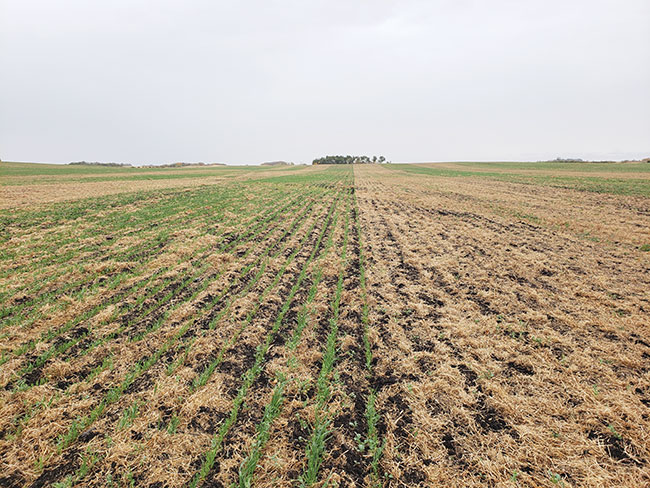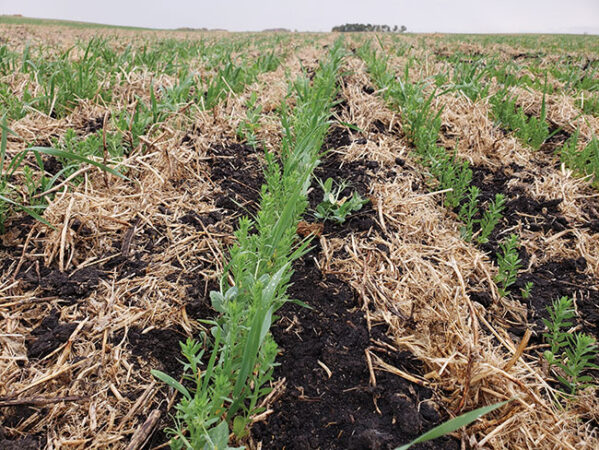
Features
Cover Crops
Fall cover crops assessed in Manitoba
On-farm field testing found negative impacts on yield and economics during three dry years, but potential for other benefits.
March 13, 2024 By Bruce Barker
 Penner’s research compared field-sized plots of cover crops to a control.
Photos courtesy of Dale Penner.
Penner’s research compared field-sized plots of cover crops to a control.
Photos courtesy of Dale Penner. The value of a fall cover crop depends on a farm’s objective. Cover crops prevent soil erosion, increase biodiversity and provide soil and environmental benefits. On the other hand, there are labour, seed and equipment costs. A network of multi-year on-farm trials in Manitoba looked at how cover crops could fit into annual grain rotations. A cost-benefit analysis for adopting this new practice was also conducted.
“When this project started in 2019, there was limited on-farm research on the Prairies looking at the agronomic and economic impacts of growing cover crops on the following cash crop and on soil health,” says Dale Penner, a master’s student under the supervision of Yvonne Lawley in the Department of Plant Sciences at the University of Manitoba.
Penner conducted his research from 2019 to 2021 at six sites across southern Manitoba near Brandon, Cartwright, Dominion City, Homewood, Roland and Rosenfeld. Each field had four replicates of paired field-length plots. The farmers followed their standard crop rotation and established a fall cover crop in each year when environmental conditions allowed. He says there were 10 different cover crop combinations grown between the six fields over the three years.
The cover crop species varied between fields, but most farmers used fall rye or oats. Other broadleaf species that were tried included flax, peas, phacelia, sunflower, crimson clover, canary seed, buckwheat and radish. Of the 17 site-years, 12 were successfully seeded to a fall cover crop after harvest, while the other five were harvested too late to allow seeding and establishment. Crops such as pinto beans and soybeans were harvested too late for establishing fall cover crops.
Cover crop seeding dates were guided by the window used for winter wheat. Most of the cover crops were sown between late August and before Sept. 15.
“The seeding date varied by farm. As part of the project, we wanted to observe farmers making decisions in real-world scenarios,” says Penner.
Termination method of the cover crop depended on the species. Fall rye was terminated either in the fall or spring with a herbicide. Other species were winter-killed.
The fall cover crop strip was compared to the adjacent control strip without a cover crop. Fall dry matter establishment and ground cover percentages were measured just before the first fall frost. Fall emerging weeds and volunteers were not controlled with herbicides in the control strips because the width of the strips did not match up with the farmers’ sprayer boom widths.
“Although this was a limitation in the study, we learned that volunteers and weeds could make a significant contribution as a cover crop from the control treatment,” says Penner. “Unfortunately, this likely minimized the treatment differences between the cover crop and the control treatment in our study.”
Grain yield was measured annually for the cover crop and control plots, and the Saskatchewan Assessment of Soil Health score was used to assess changes in soil health after three years.

A cover crop of oats, flax, sunflowers and peas seeding into pea stubble.
Increased dry matter and ground cover
Of the 11 site-years where dry matter weight was measured, four site-years had significantly higher dry matter yield with a fall cover crop when compared to the volunteers in the control treatment. Due to the short fall growing season after harvest and dry conditions that often limited fall cover crop emergence, Penner says the control treatments with weeds and volunteers often resulted in dry matter yield as high as the cover crop.
In the case of ground cover, the story was a bit different. Seven of 11 fall cover crop treatments had significantly higher fall percentage ground in the cover crop treatment compared to the control treatment. “The fall cover crop was much more uniform than the control. The ground cover from the growth of the weeds and volunteers in the control treatment was unevenly distributed,” says Penner.
Lawley says the use of volunteers as a cover crop needs to be investigated further. “It’s an interesting concept that makes a cover crop easier to implement. There is a saving in seed and labor costs, but there may be some negative implications such as disease carryover to watch for with volunteers.”
Negative yield and economic impact
Yield of the following crop was lower where a fall cover crop was grown compared to the control treatment when averaged over six site-years. Small differences of a one to two bushels per acre decline were measured.
“We didn’t see any differences in soil moisture when it was measured in the fall and spring after the cover crop. Soil nitrogen tests in the fall and spring also had very marginal differences, so it is hard to say why there was a yield drag,” says Penner.
In the second year after a cover crop, there was no difference in yield between the cover crop and the control strips.
The negative economic impact of a fall cover crop was mainly related to the loss of yield and the additional seed costs. The average loss was $72.47 per acre ($179/ha) but ranged from a loss of $151/ac ($373/ha) to a profit of $25.91/ac ($64/ha).
One of the six sites had a significant improvement in its soil health score when compared to the control treatment. Lawley was expecting that a longer time frame, perhaps five years, would be needed to see measurable changes in soil health.
“The fields in the study are representative of their area, but the farmers themselves aren’t what I would call a ‘control’ farm. They are early adopters and have an interest in practices to advance soil health. Some have been in minimum and no-till for many years with diverse crop rotations, so their soil health score is already high,” says Lawley. “It wasn’t surprising that we didn’t see a difference in soil health in all of the experiment fields after three dry years.”
Penner says for widespread adoption in Manitoba, the long-term benefits to the soil and environment need to balance the economic costs, especially when conditions are dry.
“It depends on your goal. Cover crops could be most beneficial following low-residue crops, especially where soils are prone to erosion,” says Penner. “In these situations, keeping the soil in place would provide a major economic benefit over the long term.”
Lawley says the research provided important data over three dry years.
“It is important to keep expectations realistic. In dry years, a fall cover crop may impact yield, but in wetter years, a cover crop can help use some of the excess soil moisture to improve crop production,” says Lawley. “This on-farm research project cracked open opportunities to learn about the potential of fall cover crops in annual grain rotations and about how we may need to adapt their management to include things like intercropping cover crops with spring cash crops to overcome some of the challenges we faced during these three dry years in the eastern Prairies.”
Support for this research came from Manitoba Agriculture through the Canadian Agricultural Partnership, General Mills and Agriculture and Agri-Food Canada’s Living Labs program. This research wouldn’t have been possible without the farmer co-operators.